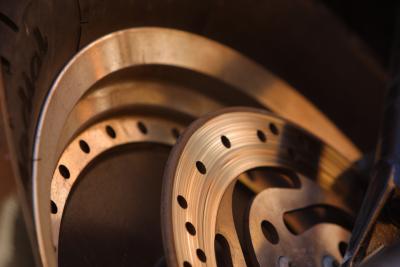
There's no hyperbole in saying there are nearly as many different kinds of brake pads as there are kinds of tires or cars on the road. The brake pad is but one component of a whole system designed to scrub off kinetic energy and turn it into heat; before choosing a set, be realistic about your car's operating conditions and what you expect in terms of performance, durability, cost and driveability.
The standard brake pad is a cocktail of various friction materials bonded together with an organic resin and reinforced with cellulose or glass fibers. Kevlar-reinforced pads are essentially standard non-asbestos organic (NAO) pads that use a combination of high-strength fibers to reinforce the pad's friction material, which enhances thermal stability and durability while reducing abrasion on the rotor. Sintered metal pads start out as a copper-electroplated steel backing plate; manufacturers deposit onto this plate a mixture of copper and zinc or copper and tin, then pass the whole pad through a furnace to fuse everything together.
It's hard to make a blanket statement about Kevlar pads and performance, because the Kevlar itself is only one small part of the NAO pad equation. The friction materials used determine most of the pad's performance, which manufacturers can bias toward noise reduction, fade resistance, reduced brake dust or thermal stability. In terms of thermal stability and braking performance, Kevlar pads tend to rank well above standard NAO pads but below semi-metallic pads -- which use metal reinforcing fibers -- and well below sintered pads. In terms of braking power and performance at high temperatures, only the super-exotic full-ceramic setup even rivals sintered pads in outright braking power and performance at high temperatures.
Sintered metal pads may be incredibly powerful and the choice of pro racers worldwide, but they have their drawbacks. Sintered pads work very well at high temperatures, but they're dogs otherwise. Being made of nothing but metal, cold sintered pads provide about as much stopping power at low temperatures as you would expect cold metal to provide. The sintered pad's heat requirement means cold pads require more pressure to produce the requisite friction, which gives them all the modulation of a light switch; sintered pads are either on, or they're off. Kevlar and NAO pads may lack the sintered pad's stopping power and fade resistance, but they always work smoothly and progressively at all but the very highest temperatures.
Kevlar-reinforced pads might best be thought of as an upgrade over the standard glass-reinforced pad but aren't the best choice from a performance standpoint. Even a basic semi-metallic pad will provide the same hot wear and fade resistance and better stopping power than a quality Kevlar unit, albeit at the expense of noise, wheel dust and a bit of longevity. Sintered pads are best left either to full-on race cars or motorcycles, which use very small pads that get up to temperature quickly. If you're building a race car or bike and want to upgrade to sintered pads, bear in mind they'll eat standard rotors alive; factor a set of new stainless steel rotors into your cost equation.